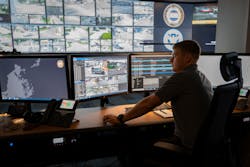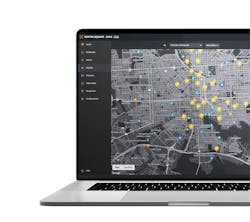Integrating Technology: Juggling Public Safety Mission with High-Tech
Technology is now ingrained in law enforcement. Body cameras, in-car video, fixed cameras, ALPR and software solutions all play a role in how officers do their jobs. Having to juggle the existence of this technology with the mission to keep the public safe can be a cumbersome task, but the companies behind these products have made a lot of progress in making that challenge easier for agencies.
This article appeared in the March/April issue of OFFICER Magazine. Click Here to subscribe to OFFICER Magazine.
OFFICER Magazine spoke to representatives from several manufacturers about how their products exist in the overall ecosystem of public safety-specific technology.
Cameras everywhere
Jim Wolfinbarger, who retired as Chief of the Colorado State Patrol in 2013 and is now the Director of Solution Sales at Motorola Solutions, says the interrelationships between devices and software offer benefits for agencies and create better outcomes. “In a patrol car, the more information you have coming at you, the less focus and attention you have in really being able to ingest it,” he says. “Today’s technology, and our efforts at Motorola, is really not just whether it’s the physical co-location or the interfacing of disparate data parts together. It really relies on bringing this information together and surfacing insights that have application and importance to that officer on the edge.”
He says the goal is to limit the manual effort required for frontline officers so they are spending “less time burning cycles on things like ensuring that they are having to do the things to manually collect and connect the pieces together.”
David O’Connor, i-PRO Americas Director of Public Safety, says one of the main goals is to design the devices so the stress of managing the data they gather is taken off officers on the street. “In the mobile category, we have that dynamic of an officer or a first responder wearing the device on the exterior of his or her uniform on a daily basis,” he says. “It’s being attached; it’s being removed. It’s going into hostile environments all the time, in and out.”
O’Connor says there are challenges when an entire agency’s officers are wearing devices and driving vehicles with multiple cameras. “They are generating an enormous amount of video, most of which will never be reviewed or needed for investigations or prosecutions. A lot of it is simply recorded as standard operating procedure,” he says. “We want to minimize the intrusion of dealing with the video on their other responsibilities—which are arguably more important—but still be able to produce exceptionally high-quality video evidence when it is needed from that daily routine of collecting everything.”The role of software
Motorola’s Command Central Aware software solution uses a common interface to unify data together, according to Wolfinbarger. “Our ability within that to be able to take those feeds from in-car, on-body, fixed video and from other sensors in the environment, to be able to put that back in geo-contextually and provide a re-creation of an event immediately following the event, which is really important in terms of things that I would ask for as a chief.”
O’Connor says officers and command staff need access to evidence in a flexible, powerful back-end system, where events are organized according to agency policies and secured according to individual roles. The back-end system has unique search and review capabilities essential to investigators. “An example of this at i-PRO Public Safety is our new synchronized playback capability within UnifiedDigital Evidence (UDE) software, where we can bring multiple related video and audio streams together precisely, with the ability to view those side-by-side or in a multi-window format so that we can see multiple viewpoints simultaneously from different devices that we’re recording either at one scene or even potentially at multiple scenes.”
He adds that consistent time code across multiple devices makes it possible for agencies to be able to synchronize multiple video feeds. “We rely on GPS time code for a lot of the mobile devices, and that gets us close enough for date and time,” he says. “If one officer’s body-worn camera started recording now and another officer arrived on scene and started recording a few minutes later, we can still go back after the incident and bring those two videos together.”
Artificial intelligence
Wolfinbarger says artificial intelligence can play a big role when it comes to culling the information once it’s collected. “I think it’s one of the most important elements of it,” he says. “A digital collection of information allows AI to be most effective when we can be able to do things like categorize, classify and arrange data in a way that makes it more actionable in near real-time.”
He cautions that the real point of AI isn’t to replace human decision-making, but rather to augment it. “Everything should be working and evolving and moving to a point that focuses on developing better outcomes for frontline responders,” he says. “If technology exists, it should exist to that point.”
O’Connor says this intelligence could help create a more streamlined workflow for all the devices that are bringing video into the system. “The devices themselves continue to become more and more intelligent. So, we see the potential advantages of artificial intelligence within each device. It’s already prevalent across the i-PRO portfolio of fixed video surveillance products. It’s a different challenge to implement that same artificial intelligence in a mobile device due to limitations of size, battery life, and operating time during an officer’s shift. AI puts additional demands on a device, but it also offers this opportunity for the devices to do more work for us on the front end and potentially save a lot of effort on the back end.”Integrating CAD
CentralSquare Unify allows nearby agencies to connect to their CAD systems from any vendor. “The interface that the agencies use for Unify is their existing CAD system. Unify is seamlessly integrated into their CAD, becoming part of their system,” says Tim Boyle, Chief Customer Officer for CentralSquare Technologies. “Almost every major CAD vendor either already has or is creating an adapter to the CentralSquare Unify hub, so compatibility with any other CAD vendor or system is possible. For the few CAD vendors that do not have a connector into Unify, we have an API that allows them to connect their CAD into our patented hub interoperability architecture.”
Boyle states that seamless integration simplifies collaboration during large-scale events such as active shooter situations and natural disasters. “During major events, where there is no time to waste, 911 centers don’t have to spend valuable minutes on the phone calling to see if units are available or passing information along,” he says. “With Unify, that information is right there in the existing CAD system, making it easy to dispatch the best unit to every call while sharing information in real-time without the need to take extra steps to pick up the phone, check notification boxes or log into another application.”
This article appeared in the March/April issue of OFFICER Magazine.
About the Author
Paul Peluso
Editor
Paul Peluso is the Managing Editor of OFFICER Magazine and has been with the Officer Media Group since 2006. He began as an Associate Editor, writing and editing content for Officer.com. Previously, Paul worked as a reporter for several newspapers in the suburbs of Baltimore, MD.




